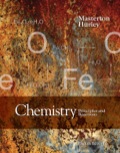
Concept explainers
Silicon
Interpretation:
To estimate the abundances of first two isotopes of silicon.
Concept introduction:
Average atomic mass = It may be defined as the sum of all the masses of its known isotopes, each multiplied with its natural abundance (in percentage) divided by 100. Mathematically,
Answer to Problem 27QAP
Abundances of first two isotopes of silicon are 92.09 % and 4.95 % respectively.
Explanation of Solution
According to question there are three isotopes of silicon (Si) such that:
Mass of heaviest isotope = 29.9738 amu
Abundance of heaviest isotope = 2.96 % (given)
Mass of first isotope = 27.9769 amu
Abundance of first isotope = Let it be ‘k’ %.
Mass of second isotope = 28.9765 amu
Since sum of abundances must be equal to 100 %. Therefore,
Abundance of second isotope = [100- (k + 2.96)] = (97.04- k) %
Making tabular data as:
| Isotopes | Mass of isotopes(amu) | % abundance |
| Heaviest isotope | 29.9738 | 2.96 |
| First isotope | 27.9769 | k |
| Second isotope | 28.9765 | (97.04 - k) |
Average atomic mass of silicon (Si) = 28.0855 amu.
Substituting the values in formula to get average atomic mass as:
Hence abundance of first isotope = k = 92.09 %
Abundance of second isotope = 97.04 − k = 97.04 − 92.09 = 4.95 %
Abundances of first two isotopes of silicon are 92.09 % and 4.95 % respectively.
Want to see more full solutions like this?
Chapter 2 Solutions
EBK CHEMISTRY: PRINCIPLES AND REACTIONS
- For the condensation reaction between Alamine and histamine, please help me write the amididation reaction mechanism. Then write the three letter code for the product of the reaction, then write the one letter code for the product of the reaction. arrow_forwardHow to draw the reaction mechasnism belowarrow_forwardName the following molecules with IUpacarrow_forward
- What is the molecular orbital for cyclopropenyl anion and is it aromatic, antiaromatic or nonaromatic?arrow_forwardUsing the chart describe the change from cystine to tyrosine and its impact on the protein. Using the chart describe the change from histidine to aspartic acid and its impact on the protein.arrow_forwardHow to get the predicted product of this reaction belowarrow_forward
- Please help me fill out the chart then using the chart describe the change from cystine to tyrosine and its impact on the protein. Then using the chart describe the change from histidine to aspartic acid.arrow_forwardWrite the Esterification reaction mechanism for acetic acid, and one propanol to make propanol ethanoate (molecule that gives peas its odor in flavor)arrow_forwardProvide solutionsarrow_forward
 Chemistry: The Molecular ScienceChemistryISBN:9781285199047Author:John W. Moore, Conrad L. StanitskiPublisher:Cengage Learning
Chemistry: The Molecular ScienceChemistryISBN:9781285199047Author:John W. Moore, Conrad L. StanitskiPublisher:Cengage Learning Chemistry & Chemical ReactivityChemistryISBN:9781337399074Author:John C. Kotz, Paul M. Treichel, John Townsend, David TreichelPublisher:Cengage Learning
Chemistry & Chemical ReactivityChemistryISBN:9781337399074Author:John C. Kotz, Paul M. Treichel, John Townsend, David TreichelPublisher:Cengage Learning Chemistry & Chemical ReactivityChemistryISBN:9781133949640Author:John C. Kotz, Paul M. Treichel, John Townsend, David TreichelPublisher:Cengage Learning
Chemistry & Chemical ReactivityChemistryISBN:9781133949640Author:John C. Kotz, Paul M. Treichel, John Townsend, David TreichelPublisher:Cengage Learning Chemistry: Principles and PracticeChemistryISBN:9780534420123Author:Daniel L. Reger, Scott R. Goode, David W. Ball, Edward MercerPublisher:Cengage Learning
Chemistry: Principles and PracticeChemistryISBN:9780534420123Author:Daniel L. Reger, Scott R. Goode, David W. Ball, Edward MercerPublisher:Cengage Learning ChemistryChemistryISBN:9781305957404Author:Steven S. Zumdahl, Susan A. Zumdahl, Donald J. DeCostePublisher:Cengage Learning
ChemistryChemistryISBN:9781305957404Author:Steven S. Zumdahl, Susan A. Zumdahl, Donald J. DeCostePublisher:Cengage Learning Chemistry: An Atoms First ApproachChemistryISBN:9781305079243Author:Steven S. Zumdahl, Susan A. ZumdahlPublisher:Cengage Learning
Chemistry: An Atoms First ApproachChemistryISBN:9781305079243Author:Steven S. Zumdahl, Susan A. ZumdahlPublisher:Cengage Learning





